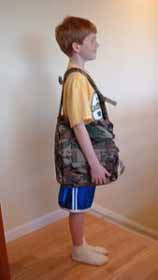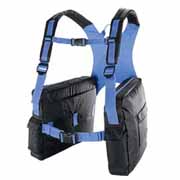The BackTpack story
The incidence of backpack-related pain and injury continues to rise and has reached epidemic proportions in our kids. What we see is probably just the tip of this iceberg, as kids underreport pain and many parents discount the pain reports they do get, because their "kids are young” and parents see no alternative.
The term “backpack safety” is an oxymoron. While many articles offer guidelines in “backpack safety”, the fact remains that backpacks are off-axis, posterior loading systems that cause the body to compensate with postural distortion. The postural distortion will continue unless the load is aligned with the body’s axis, in obedience to the laws of physics and physiology. It is this postural distortion as well as the posterior protrusion of the backpack that is chiefly responsible for the pain and injuries associated with conventional backpack use.

Postural distortion with a conventional backpack.

Good posture with the BackTpack axial loading system.

Postural distortion with a conventional backpack.

Good posture with the BackTpack axial loading system.
Since postural distortion, not the magnitude of the load, is a chief disabling factor, switching to a rolling backpack is a short-term remedy, not a solution. A rolling backpack provides no postural training — the mechanism is actually heavier and more awkward when carrying is required (e.g., on busses, stairs, irregular surfaces) and unloading the body is not necessarily a healthy alternative for developing bones. Only during the growth period can bones build density. This also requires adequate daily muscle/bone resistance. Our young people are getting less and less activity. Carrying their books may be their only opportunity for adequate exercise to increase bone density and prevent osteoporosis, the leading cause of fractures in adults, and increasingly seen in children.
The safety hazards inherent in the design of the backpack, originally intended for mountain recreation, not as a school bag or everyday bag – compelled physical therapist Marilyn von Foerster to design a healthy alternative for school or everyday use: the BackTpack.
SAFETY CONCERNS with use of a conventional backpack
- Posture distortion, including forward head, rounded shoulders, anteriorly tilted pelvis, hyper-extended knees, and poor foot alignment. Backpack use encourages thoracic kyphosis (rounded spine) and cervical hyperextension, causing neck pain.
- Pain and injuryto the back, neck, and shoulders from poor posture, poor body mechanics, and the twisting and forward bending associated with the need for frequent removal in order to sit.
- Injury to othersas the user is unaware of posterior bulk of a conventional backpack and can easily knock others down when turning quickly.
- Poor security. The pack is accessible to those behind you, not to you. A backpack must be removed to access items or to sit down. It is difficult to run while wearing a backpack. must remove for access;
- Biking instability. Backpacks are top heavy and loads can suddenly shift, leading to poor control of the bike.
- Emergency evacuation concerns. Speed, access, and uphill running are difficult (e.g., Tsunami evacuation), and there is danger to others in a crowd when turning. Conventional backpacks stored on the floor create trip hazards during evacuation of classrooms.
- Balance disturbance is related to posterior loading.
It is a neuromuscular training fact that when resistance is applied against a given direction of movement, that movement is strengthened and trained. Upright posture can be trained by loading the body on its vertical axis, for example, a book on the head or a balanced bilateral load.
The only way to correct the habitual postural distortion trained by a posterior loading system is to apply the load on the axis instead of on the back. If we apply these clinically sound principles to the everyday loading system of students, we will train their lifelong postural habits for musculoskeletal health.
SOLUTIONS FOR SAFETY with the BackTpack
- Posture distortion is eliminated. The spine is loaded axially. There is no leaning. The body's reaction to the load is a vertical posture.
- Pain and injury is reduced or eliminateddue to improved posture and body mechanics. With a postural training system of axial loading and the ability to sit with BackTpack on, loads are transferred off the spine and shoulders onto a strap over the thighs. Since the bag's compartments are always accessible, the wearer can sit unloaded with the bag on and there is no need to frequently take the bag off.
- Reduced risk of injury to othersassiciated with the user being unaware of the posterior projection of a conventional backpack. The BackTpack wearer is always aware of personal space related to bag he/she is wearing and can accommodate space so as not to impose it on others’ safety.
- Improved security. The wearer’s items are accessible only to the wearer, and the bag does not need to be removed when sitting.
- Increased biking stability and improved biking posture. The BackTpack provides a lower center of gravity, is a balanced load, and compartments are easily accessed. When in the forward lean position, the load is applied to the body in a posterior-to-anterior direction against the spine (rather than from shoulders), promoting a neutral spinal alignment of thoracic spine and neck.
- Postural distortion is eliminated. Since the BackTpack is a postural training system with an axial load, there is no postural distortion as the weight of the load increases. The limit of the load increase is a matter of comfort to the wearer. Some or all of the load can be transferred to the hips via the optional hip loading system provided in the design.
- Support emergency evacuation. The BackTpack remedies all of the safety issues associated with a conventional backpack. The BackTpack wearer benefits from improved balance and greater mobility. BackTpacks do not need to be removed when sitting in classrooms, and if removed can be draped on the seat. This eliminates trip hazards and floor obstacles during classroom evacuation.
- Improved balance. There is no balance disturbance with axial, bilateral loading. Balance is reinforced.
Based on 30 years of evidence, backpacks continue to cause postural distortion, pain and injury when used as a daily school bag in spite of “backpack safety” programs and guidelines. Using the BackTpack as a school bag effectively addresses the issues contributing to these problems.
If students insist on using their backpacks for school, they and their parents should be aware of the long term physiological effects and how best to mitigate them with appropriate exercises, training in posture and body mechanics, and to be informed of healthy alternatives for carrying their supplies.
Article reproduced with permission from Marilyn Miller von Foerster PT, MA, Salem, Oregon.

The BackTpack side-pack carrying system